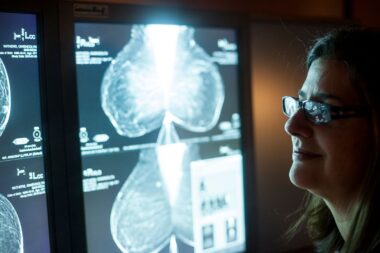When it comes to cancer risk, genes can play a significant role. Women who carry BRCA1 or BRCA2 gene mutations have a significantly higher risk of developing breast or ovarian cancer compared to the general population. In fact, it is estimated that up to 10% of breast cancer cases are hereditary, which means they are caused by an inherited genetic mutation, most commonly BRCA1 or BRCA2 genes. Not every woman who has genetic risk factors will develop cancer during her lifetime, but if you have a family history of breast cancer, BRCA gene testing can play an important role in understanding your personal risk profile and informing a preventive breast health plan that’s right for you.
Early detection and timely intervention can lead to better survival rates for women with BRCA mutations who develop breast or ovarian cancer. By maintaining annual screening mammograms and regular health checks for ovarian cancer risk, you can become empowered and knowledgeable about your personal risk.
What Are BRCA Genes?
BRCA1 and BRCA2 stand for breast cancer genes 1 and 2. Everyone inherits two copies of these genes, one from each parent. Normally, BRCA genes create proteins that help restore damaged DNA and suppress the growth of tumors. When these genes have harmful variants, they can put women at greater risk of developing cancer, especially breast and ovarian cancer.
If you have a parent who carries a mutation in either of these genes, you have a 50% chance of inheriting the mutation yourself. Even so, you will still have a normal copy of the gene from your other parent, but the copy can become lost or change throughout your life. When cells don’t have any normal BRCA1 or BRCA2 proteins, they can grow out of control and become cancerous.
Who Should Have BRCA Gene Testing?
The National Comprehensive Cancer Network recommends genetic testing for people who are at higher risk of developing breast or ovarian cancer. This includes people who:
- Have a family history of breast or ovarian cancer
- Have a relative with a harmful variant of BRCA1 or BRCA2
Additionally, leading organizations further recommend women who have been diagnosed with breast cancer at a young age, have had two or more cancer diagnoses, or have been diagnosed with epithelial ovarian cancer undergo genetic testing. Your doctor can discuss your family history with you and refer you to resources for genetic counseling and testing.
The BRCA Gene Testing Process
You will begin with a consultation with a genetic counselor, who can help you decide whether genetic testing is right for you. The test is performed by collecting a blood or saliva sample, which will be sent to a lab for analysis.
Several results are possible:
- Negative result: This means that no known mutations were detected, and you are not at higher risk of breast or ovarian cancer.
- Positive result: The presence of BRCA1 or BRCA2 mutations was detected, and you are at higher risk for developing cancer. This also means the variant can be passed on to your children and that other blood relatives could have it.
- Variant of uncertain significance (VUS): This result means a change has been detected in BRCA1 or BRCA2 genes, but it isn’t known if this variant is harmful. Further evaluation is necessary to determine cancer risk.
What Happens After a Positive BRCA Test Result
Women with harmful variants of BRCA genes have a higher possibility of being diagnosed with breast cancer by age 70. Those with the BRCA1 mutation have a 55-65% chance of developing breast cancer, while those with the BRCA2 mutation have a 45% chance.
By working with your doctor and genetic counselor to develop a personal risk profile, a breast health plan, and a surveillance strategy that’s right for you, you increase the chance of early detection. Part of your plan may include:
- Beginning annual screening mammograms at an earlier age. For women of average risk, the recommended age to start annual screening mammograms is 40. For women at higher risk, breast health guidelines recommend baseline screening at 35 or to begin screening 10 years before the age of diagnosis of your first-degree relative. So, for example, if your mother (or sister) had cancer at 42, then you would start screening at 32.
- Including supplemental screening in your surveillance plan. For example, having breast MRI imaging in addition to screening mammography (typically at six-month intervals between annual screenings), as advanced MRI technology can detect some cancers that cannot be seen on a mammogram
- Having a breast ultrasound performed if a change in breast tissue or other concern is detected on your annual screening mammogram. Breast ultrasound is often used as part of a diagnostic exam to further evaluate an area of concern.
- Taking chemoprevention medicine to reduce cancer risk
Some women with BRCA mutations may opt for risk-reduction strategies, such as mastectomy (surgical removal of the breast tissue), or oophorectomy (removal of ovaries) or risk-reducing medications. These options can be discussed with healthcare providers, but regular screening mammography remains an important part of overall breast health management. Your healthcare provider, along with your genetic counselor and/or breast health navigator, can discuss your options, as well as the benefits and risks that come with them, so you can make the best decisions for yourself. Additionally, you may want to consider including a close family member, partner or trusted friend in some of these discussions and decisions, as they will be there to provide support throughout your journey.
Looking Ahead
Research in genetic testing is ongoing, with experts hoping to develop personalized approaches to preventing cancer based on genetic testing. If you test positive, remember to stay informed about advancements in this field. And remember, regular well visits, including clinical exams for breast cancer and cervical cancer screenings, empower women with BRCA gene mutations to take an active role in their health. Understanding the role that genetics plays in personal risk helps women make more informed decisions about their own breast and reproductive health as they age, including possible preventative and risk-reducing measures that can help improve the quality and longevity of life.
Above all, if you meet the criteria for genetic testing, talk to your provider about your options. Whether you are at high risk or average risk for cancer, making informed choices on prevention and early detection is an important part of taking care of your health.



